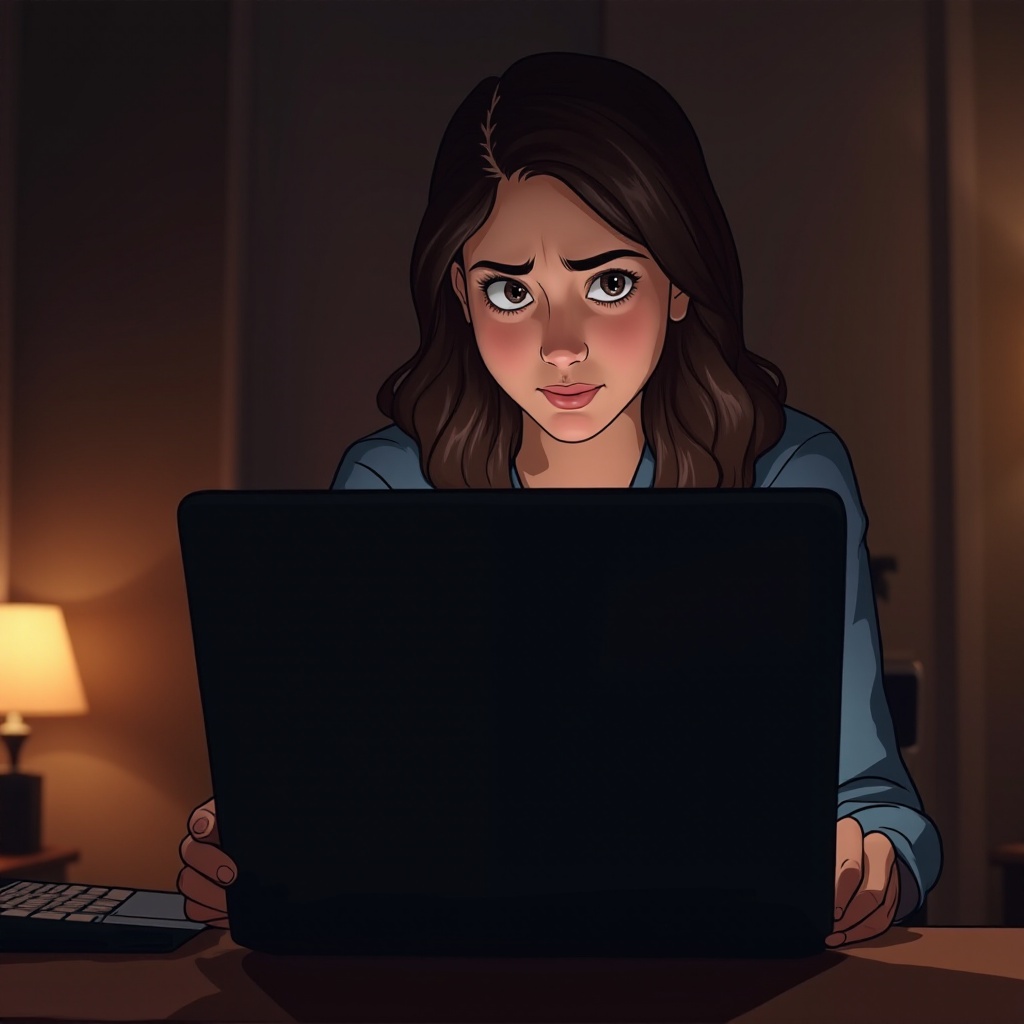Introduction
Dealing with a laptop screen that goes black unexpectedly can be extremely disruptive. This common issue not only interrupts work but can also spoil your enjoyment during leisure activities. The good news is that this problem can often be traced back to specific causes. Recognizing this can help navigate the repairs more effectively. In this guide, we’ll walk you through various steps to diagnose and fix the issue, from basic checks to more technical solutions, and when it’s time to reach out to a professional for help.

Initial Diagnostics
The first course of action when your laptop screen goes black randomly is to perform some initial diagnostics to rule out basic issues.
Power Source and Connection Checks
-
Inspect Power Connections: Check if the power cable is securely connected to your laptop and the power outlet. A loose connection might be the root cause of unexpected screen blackouts.
-
Battery Status: Examine the battery’s condition and charge status. Insufficient power supply due to a depleted battery could lead to screen problems.
-
Test the Power Button: Press the power button to confirm whether the laptop is switched on. This step helps to ensure that the problem is indeed with the screen and not just a power setback.
Verifying these connections can often resolve the issue quickly if the problem lies with the power source.
Software-Related Causes and Solutions
If power issues are ruled out, investigate software-related issues that might be causing the laptop screen to go black.
Update and Reinstall Graphics Drivers
-
Check for Updates: Graphics drivers that are out-of-date can lead to screen issues. Use the device manager or the manufacturer’s website to check for available driver updates.
-
Reinstall Graphics Drivers: Should updating the driver not solve the problem, try reinstalling it. Uninstall the existing driver and reboot your laptop to allow automatic reinstallation of the default drivers.
Boot in Safe Mode
-
Access Safe Mode: Boot your laptop in Safe Mode, which loads only essential system drivers and can help identify if third-party software underlies the screen issue.
-
Monitor Behavior: Watch the screen’s behavior while in Safe Mode. If the problem ceases, a particular application or software could be responsible.
Check for Operating System Updates
-
System Updates: Regular OS updates often contain fixes for bugs that might be behind screen issues. Make sure your operating system is current.
-
Automatic Updates: Turn on automatic updates to ensure timely installations of future patches and prevent related problems from arising.
Conducting these updates can smooth out performance inconsistencies that might lead to black screens.

Hardware Troubleshooting
If software troubleshooting yields no results, it’s time to delve into hardware components of your laptop for potential issues.
Examine Display and Cable Connections
-
Inspect Display Connections: If you use an external monitor, double-check the connections are firmly in place.
-
Internal Cables: For those comfortable with opening laptops, inspect internal cables to confirm they are firmly connected and not damaged.
Test with an External Monitor
-
Connect External Monitor: Use an appropriate cable to link your laptop to an external monitor to diagnose the screen condition.
-
Monitor Comparison: If the external monitor functions normally, the problem might reside in the laptop’s screen itself.
Battery and Power Supply Issues
-
Battery Health Check: An aging battery might be at fault. Use system reports to evaluate battery health.
-
Try a Different Charger: Testing a different charger can rule out power supply discrepancies that might lead to screen blackouts.
These hardware troubleshooting steps can aid in identifying specific hardware faults causing screen issues.
Preventive Measures and Maintenance Tips
Preventive care can greatly enhance your laptop’s lifespan and minimize the probability of screen blackouts.
Regular Software and Driver Updates
Consistently updating software and drivers ensures your laptop runs smoothly and is safeguarded against security threats.
Ensure Proper Ventilation and Cooling
-
Clean Air Vents: Regularly remove dust from air vents to maintain optimal airflow and prevent overheating, which could lead to a black screen.
-
Use Cooling Pads: Employ cooling pads for extra support, especially during intensive tasks that elevate device temperature.
Taking proactive steps helps maintain your device, decreasing the likelihood of unforeseen screen blackouts.

When to Seek Professional Help
Should your attempts to fix a randomly blacking out screen be unsuccessful, professional assistance may be necessary. Technicians are equipped to handle complex hardware issues like potential motherboard faults or display failures. Consulting with an expert can expedite issue resolution and relieve troubleshooting stress.
Conclusion
Successfully addressing a laptop screen that goes black involves systematic troubleshooting that spans power source verification, software updates, and hardware checks. While many issues can be rectified without external help, others may demand professional input. Consistent maintenance and updates can help avert future problems, ensuring your laptop’s uninterrupted function.
Frequently Asked Questions
Why does my laptop screen go black for a few seconds?
Temporary black screens may result from outdated graphics drivers or minor system errors. Regular updates and diagnostics usually resolve these issues.
Can a faulty battery cause the screen to go black?
Yes, a failing battery might cause inadequate power supply, leading to a black screen. Testing with a new battery could confirm the issue.
Should I reset my laptop if the screen goes black randomly?
Resetting may solve software-related issues; however, attempt the outlined diagnostics and troubleshooting methods before considering a reset.

